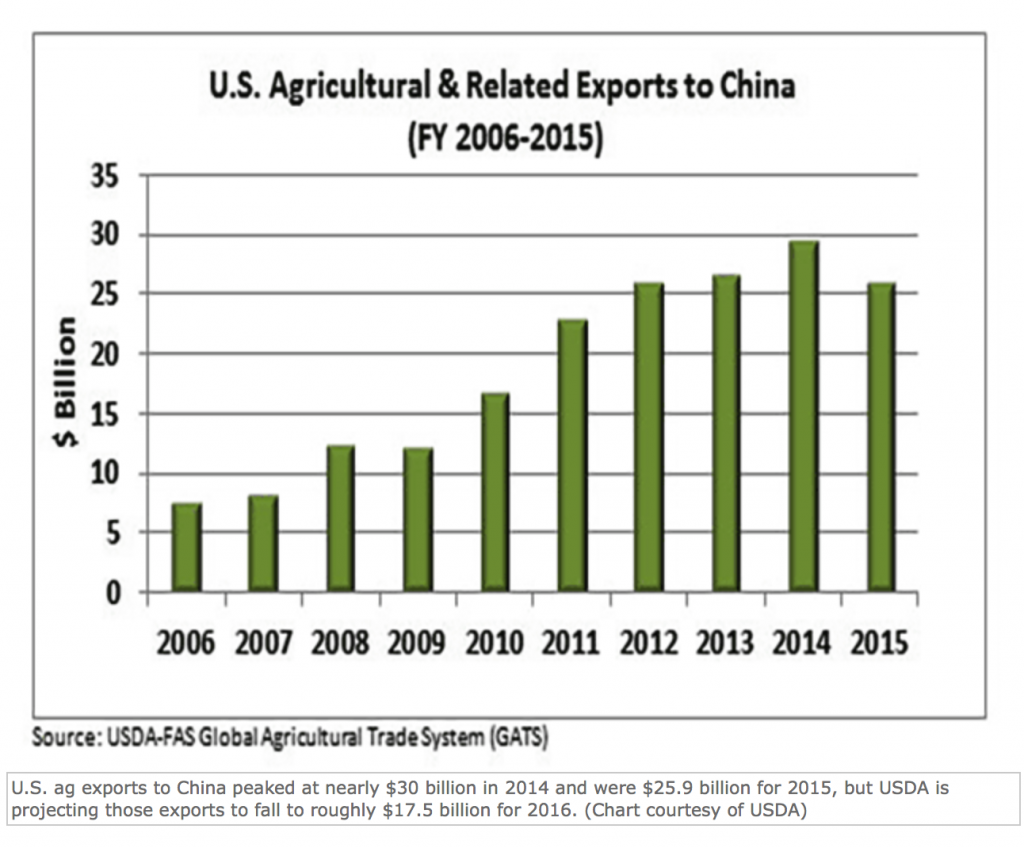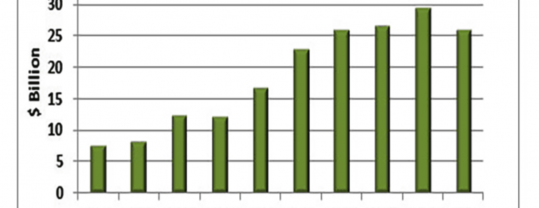By Chris Clayton, DTN Ag Policy Editor
ARLINGTON, Va. (DTN) — China has become the object of affection for U.S. agricultural exporters over the past decade, but the affair is on shaky ground because there are cheaper dates out there right now than U.S. commodities.
Still, American agriculture wants to protect and rekindle that relationship as farmers cope with slumping prices.
Interest in China’s food and feed plans is such that a breakout session on China’s economy and agricultural trade at USDA’s Ag Outlook Forum on Thursday was not only a standing-room only event, but there remained a line outside the session of people waiting for anyone to leave so they could get in.
China went from being a relatively small importer of U.S. products to being the top destination starting in 2011. In just the past decade, U.S. ag exports to China grew 125%, according to USDA. In 2015, China bought $25.9 billion in U.S. commodities, accounting for about 16% of all U.S. ag exports. Roughly one-third of all soybeans grown in the U.S. were exported to China.
But Chinese buyers are increasingly looking elsewhere for key products such as soybeans, corn, hides and skins, and pork. Exports to China are projected to fall to roughly $17.5 billion for fiscal-year 2016.
The decline in exports to China this year will bump Canada back to the top destination for U.S. ag products.
“The high value of the dollar is a disadvantage for U.S. exporters in the China market,” said Fred Gale, a senior economist at USDA’s Economic Research Service.
With a currency that is 25 to 27 times lower than the U.S. dollar, Ukraine is now the dominant supplier of corn to China. China limits the amount of corn that can be purchased on international markets, so importers are now looking for more alternatives to corn, such as sorghum, barley from the U.S. and cassava from Africa.
Additionally, the European Union is displacing some U.S. pork exports to China, due partly to the lower currency and partly to Russia cutting off imports of EU pork. That left EU pork companies searching for an alternative market. The EU also doesn’t allow the use of ractopamine, which is another reason China is importing more pork from Europe.
Often, observers fixate on growth in gross domestic product to gauge the overall Chinese economy. GDP in China is still growing at roughly 6.8% — more than twice the rate of U.S. GDP growth — but China’s annual GDP growth was as high as 12% six years ago. China’s GDP is expected to slow to 6.1% in 2016, 5.7% in 2017, and level off at 5% by the mid-2020s, according to USDA.
Nicholas Lardy, a senior fellow at the Peterson Institute for International Economics, noted one reason for slower growth is the real estate market in China has declined. That’s led to a decline in the use of steel, concrete and demand for coal as well.
Still, Lardy said even as GDP growth slows, employment continues to go up and per capita income also continues to increase. He points to higher growth in the service sector in China even as the industrial sector and real estate have moderated.
“They are creating as many new jobs at 7% growth as they were at 10% growth,” Lardy said.
Bryan Lohmer, director for the U.S. Grains Council in Beijing, said he remains optimistic about China’s economy, growth and future food consumption. Lohmer, though, highlighted in a presentation that it’s difficult to get accurate data on China’s grain production, consumption and carryout.
He said two Chinese companies that analyze crop production and use had very different numbers until they had a meeting with a ministry official. Shortly after, the two companies changed their numbers to match the government figures.
“When everyone tends to agree on the carryout number, I tend to be skeptical,” Lohmer said.
Lohmer said numbers also are off when it comes to projecting figures such as pork consumption per capita. Official figures would suggest pork consumption per capita is nearly comparable to European figures, but Lohmer said there was no way everyone in China is consuming 42 kilograms (92 pounds) per capita.
 In the short term, China could continue restricting imports of corn to reduce stocks that came from a policy that overpaid farmers for corn. “China has made it pretty clear that it is part of their strategy to reduce stocks,” Lohmer said.
In the short term, China could continue restricting imports of corn to reduce stocks that came from a policy that overpaid farmers for corn. “China has made it pretty clear that it is part of their strategy to reduce stocks,” Lohmer said.
Using his own ballpark figures on livestock production and consumption, Lohmer said that over the long term, China will need imports of feedstuffs for livestock. Whether those imports come from corn or other alternatives remains to be seen. China’s five-year plan calls for Chinese farmers to scale up in size and technology. Yet that policy — to buy feed grains and boost animal production — could be tested domestically because of increasing environmental concerns raised by the Chinese over large-scale livestock production.
That same five-year policy plan also encourages Chinese companies to actively pursue purchases of other food and agricultural businesses. That includes the ChemChina purchase of Syngenta, which Agriculture Secretary Tom Vilsack has repeatedly voiced concerns about in recent days. Vilsack has made it clear he doesn’t trust the process in China to approve biotechnology traits. The Syngenta purchase could give ChemChina an unfair advantage in that regard.
“I’m deeply concerned about that, from the standpoint of, will the technology that is developed and does become available, will it be treated in a fair and balanced way, globally?” Vilsack said Thursday. “Will there be any unfair advantages provided to companies in China’s regulatory system, which in the past has been less about science and more about (in my view) politics? I have a deep concern about that. And hopefully should that merger go through, there is an understanding that there is a need for China to get their regulatory system in a place that is synchronized with rest of the world and is based on science and ensures that whatever technology is developed, wherever it is developed, is given a fair and balanced review and utilization once it is deemed to be safe and available.”
Emily Unglesbee contributed to this report.
Chris Clayton can be reached at Chris.Clayton@dtn.com
Follow him on Twitter @ChrisClaytonDTN

